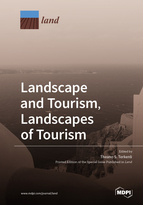Landscape and Tourism, Landscapes of Tourism
A special issue of Land (ISSN 2073-445X).
Deadline for manuscript submissions: closed (28 February 2021) | Viewed by 76796
Special Issue Editor
Interests: geographies of everyday life; landscape studies; tourism and development; identities and globalization; participatory governance
Special Issues, Collections and Topics in MDPI journals
Special Issue Information
Dear Colleagues,
Landscape is central to tourism. It is key to the development, marketing/promotion, and consumption of tourism destinations, to triggering and sustaining tourism markets, and to enticing tourist dreams, fantasies, and behaviors. From ‘sight-seeing’ practices—at the basis of all tourism activities—landscape figures prominently all the way to the overall spatial planning and management of a destination for tourism development.
The intertwined relationship between tourism and landscape comes with a series of costs and benefits, in the context of tourism landscapes. Landscapes of tourism reflect and stage recreational trends, multifunctional livelihood systems, conflicts and opportunities for employment and income generation, as well as human, cultural, and natural resource management and use. This Special Issue aims to enhance the interdisciplinary scientific dialogue on these issues and challenges, while highlighting their range and significance for tourism and the landscape, in terms of theory, empirical practice, approach, policy, ethics, and future prospects.
Some of the questions posed for consideration here are: What are landscapes of tourism, for whom and how/why? What is the role of the landscape in tourism promotion, attraction, experience? How does tourism affect the landscape? What lessons do the history and geography of tourism have to offer to tourism landscape stewardship? How may we best plan for and manage the landscape in the context of various forms of tourism growth and spread, at various scales? Scholarly advances in the past few decades have steadily built on a diverse—but spread-out and not adequately connected—bibliographical basis for future research. Much remains to be understood and exchanged as landscape and tourism—two highly complex and multifaceted scientific areas—come together in the scope of this Special Issue in a variety of ways across time, space, and culture.
Prof. Dr. Theano S. Terkenli
Guest Editor
Manuscript Submission Information
Manuscripts should be submitted online at www.mdpi.com by registering and logging in to this website. Once you are registered, click here to go to the submission form. Manuscripts can be submitted until the deadline. All submissions that pass pre-check are peer-reviewed. Accepted papers will be published continuously in the journal (as soon as accepted) and will be listed together on the special issue website. Research articles, review articles as well as short communications are invited. For planned papers, a title and short abstract (about 100 words) can be sent to the Editorial Office for announcement on this website.
Submitted manuscripts should not have been published previously, nor be under consideration for publication elsewhere (except conference proceedings papers). All manuscripts are thoroughly refereed through a single-blind peer-review process. A guide for authors and other relevant information for submission of manuscripts is available on the Instructions for Authors page. Land is an international peer-reviewed open access monthly journal published by MDPI.
Please visit the Instructions for Authors page before submitting a manuscript. The Article Processing Charge (APC) for publication in this open access journal is 2600 CHF (Swiss Francs). Submitted papers should be well formatted and use good English. Authors may use MDPI's English editing service prior to publication or during author revisions.
Keywords
- landscape
- tourism
- interrelations
- challenges
- prospects
- approaches
- stewardship






